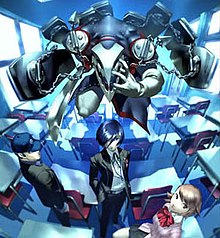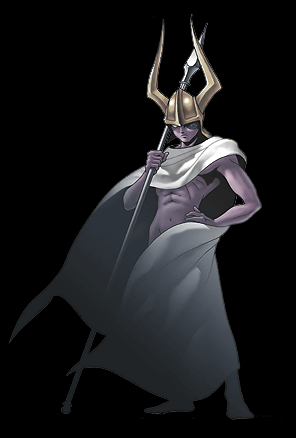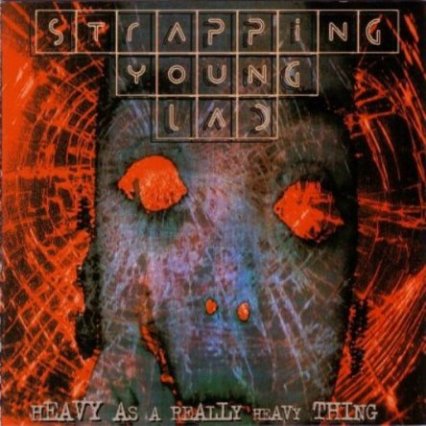So, what is Persona 3? Well, for those unaware, it's a JRPG of the Shin Megami Tensei brand which was published locally by Atlus for the PS2.
The premise of the game is that you, the silent protagonist, knows that the world will end in exactly one year, and no matter what action you take, you take full responsibility for it (comes into play towards the end). Nobody else is aware that the world will end either.
From left to right: Junpei, Main Character, Yukari. Above: Goddamn Thanatos.
Alright, so to break down the game itself. It's divided into two main parts: Day and Night. During the Day period, you go to school and can hang out after school with a variety of people to bolster your "Social Links" (a little more on those later). During the Night period you can either go out to the mall to boost some stats/find specific people, or go to Tartarus, the twisted remodeling of your school, to fight the Shadows.
This division of your day is pretty neat. Building up your Social Links is beneficial towards exploring Tartarus. Every person is assigned an Arcana, based off the major arcana from Tarot. For example, the main character is of the Fool arcana due to it's potential (Fool's number is 0). So, as you form Social Links and level them up, your ability to fuse Persona, the powers you summon from within, improves. If you have a high ranking in the Chariot Social Link for example, when you make a Chariot Persona, it'll get a huge amount of XP upon creation, leveling up several levels.
So that's the general mechanics on the game. Right now I'm devoting a whole section to the soundtrack.
Seriously.
The soundtrack is pretty interesting because it emphasizes the contrast between what goes on during the Day and Night periods. The soundtrack has an infectious vibe to it. The day time music is really light, peppy, and relaxing, whereas the night-time music is more upbeat and at times, intense.
This is what we call a fun boss theme.
That's the theme for a few different boss fights, whereas this...
Is the regular fight theme. You'd think this wouldn't work, but damn, does it it infect you. It's one of those fighting themes that can stick out during a fight, and can blend into the background at the same time.
Now, if we compare this to your after-school music...
This is what we call contrast folks. It's a pretty big theme in the game. Contrast between day and night activities, persona abilities, music, and even among the characters themselves.
Atlus pulled some pretty good talent to do the voice work for this game. Notable voice actors include Vic Mignogna (Full Metal Alchemist, Disgaea 3, other roles), Michelle Ruff (Bleach, other roles) Tara Platt (various roles), and Liam O'Brian (Final Fantasy XIII-2, other works).
Atlus seems to have a track record for bringing games stateside that people want, and for doing a damn good job of it. I haven't played Persona 4, but I hear it's another great game that was localized well.
Atlus: Giving your great RPGs since 1986... except the ones that sucked. Ignore those.
Alright, now I'm going into rambley land.
Combat in person is pretty simple. You choose whether to attack with your weapon, or to summon your persona to use a skill. Casting physical skills does some HP damage to you, while magic skills use your SP. Simple. in addition, you can only control the main character (in P3 and FES, all characters in P3P). If the main character dies, it's game over.
Done.
Fahgeddaboudit.
Also, the game takes advantage of some "elemental Rock-Paper-Scissors". While you can change your persona (even in battle), and thus, change your strengths and weaknesses, your NPC allies only have their one persona to work with.
Starting Persona, with stats somewhere between "Jack" and "Shit"
The resistances are groups into physical and magical. The first three are "Slashing", "Bashing" and "Piercing". The second group is: Fire, Ice, Electricity, Wind, Holy, and Darkness. As you can see, Orpheus is weak to Electricity and Darkness type attacks. This means that if I get hit with an electric type attack while having Orpheus equipped means I take extra damage and I get knocked down. This is detrimental because to stand up you either need to be hit, healed by an ally, or spend your next turn to stand up.
You can also use this to your advantage. If an enemy is weak to a type of attack, you can knock them down. You can also knock an enemy down with a critical hit as well. If you knock an enemy down, you get an extra turn, which can lead to knocking down all enemies. If this happens, you and all allies will bum-rush the group of baddies, dealing a good amount of damage to all of them. This makes it a good tactic to speed up the level grinding process.
Another nice feature is the equipment. While it has almost no cosmetic changes, save for a few pieces of armor, the main draw is that each weapon, accessory, and armor has a unique attribute. For example, if you find two pairs of shoes that are the same in name, they'll both confer the same stat bonus (i.e. 12 Evasion), but their unique effect may be different (Dodge Electricity: Medium Chance vs Critical Chance Up: Low). This makes managing your equipment a little more interesting. You may give an NPC a certain piece of equipment with lower stats, just because it helps neutralize their weakness.
Some other negatives about the game is that it can be repetitive at times. You need to be able to put up with the mandatory level grinding in order to be able to beat the storyline missions. Also, you should keep a manual calendar of your Social Links if you want to max a lot of them. Some only meet on certain days, so you'll need to take that into consideration.
So what's the difference between the three versions? Well, there's a couple. Between Persona 3 and FES, you gain new Persona, new Social Links, updated dialogue, a "Hard" difficulty (Seriously, this sucks. Enemies hit harder, and their status effect attacks hit you more often), and a 30-hour Epilogue. From FES to P3P, you gain access to a New Game + option, a choice of Male or Female Protagonist, which changes the Social Links around, and I'm not sure if that includes the bonus chapter...
Female and Male protagonists
All and all I'd recommend this game to people who like JRPGs. The story is surprisingly dark at time, but is often contrasted by some humorous writing and voice work. If you can put up with the level grinding, you'll find that the game has surprising depth to it. The cutscenes, though few and far-between after the start of the game, are well done.
You can find the game at various GameStops for new or used, or grab the digital version off PSN for FES.














